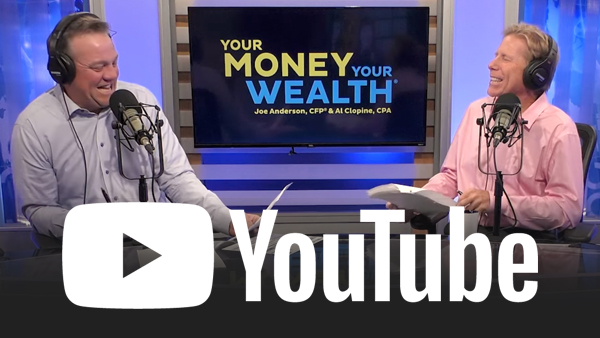Will their $5 million nest egg get them to ages 85 and 100? Pa and GiDi are 65 and 60 and retiring now. As they consider moving to the no-income-tax state of Nevada in retirement, they have some decisions to make: should Pa take Social Security before age 70? How should they bridge the gap until Social Security? And most importantly, how can they minimize their taxes in retirement – should they wait to do Roth conversions until after the move? That’s on this bonus episode of Your Money, Your Wealth®, aka YMYW Extra. While Joe Anderson, CFP® and Big Al Clopine, CPA are on vacation, YMYW producer Andi Last enlists the help of senior financial advisor Kyle Stacey, CFP® from Pure Financial Advisors in San Diego, California.

Show Notes
- (01:26) Pa & GiDi’s Cars, Drinks & Finances
- (06:46) High-Level Thoughts and Retirement Assumptions
- (10:21) Roth Conversions to the Top of the 24% Tax Bracket
- (11:40) Claiming Social Security and Portfolio Diversification
- (12:38) Other Suggestions
Free financial resources:
LIMITED-TIME SPECIAL OFFER | DIY Retirement Guide – download by Friday, July 5, 2024!
WATCH | Strategies for Diversifying Concentrated Stock Positions
YMYW Extra on YouTube | Guides | Blogs | Educational Videos | YMYW Newsletter
SUBSCRIBE ON YOUTUBE: COMMENTS ARE NOW OPEN!

Watch an alternate video spitball for Pa and GiDi on YouTube from Nick Rose, CFP®!
Transcription
Andi: Will their 5 million dollar nest egg get them to ages 85 and 100? Pa and GiDi are 65 and 60 and retiring now. As they consider moving to the no income tax state of Nevada in retirement, they have some decisions to make: should Pa take Social Security before age 70? How should they bridge the gap until Social Security? And most importantly, how can they minimize their taxes in retirement? Should they wait to do Roth conversions until after the move? That’s up next on this bonus episode of Your Money, Your Wealth®, aka YMYW Extra.
I’m producer Andi Last, and Your Money, Your Wealth® hosts, Joe Anderson CFP®, and Big Al Clopine CPA are both on vacation. So as Al enjoys Europe, and Joe celebrates his milestone birthday on a golf course somewhere in the middle of this country, I’ve enlisted the help of senior financial advisor Kyle Stacey, CFP® from the Pure Financial Advisors office in San Diego. It’s important to note that this is just a spitball, for educational purposes only. We don’t know everything about your financial situation, so don’t take this to the bank! Here’s Kyle’s spitball:
Kyle, thank you so much. I really appreciate you stepping in to help me get the YMYW listeners the answers that they’ve been waiting for for so long.
Kyle: Yeah, sounds like we got a backlog, huh?
Andi: Well, this email that we’re about to do is, like, from February. So, yeah, we’re way behind. We are way behind.
Kyle: Yeah, when I read the email originally, I thought he said, Gigi. That’s my mom’s nickname.
Andi: Oh, funny!
Kyle: Yeah, yeah. I saw GiDi.
Andi: Well, we’ll get into that. So, I’ll go ahead and read the email, and then we’ll just go through and you can give me some spitball ideas, okay?
Kyle: Let’s do it.
Pa & GiDi’s Cars, Drinks, & Finances
Andi: Alright. So, the email says, “Greetings from Pa and GiDi here in Silicon Valley. Started listening to the show 6 months ago-” now it’d be like, 8 months ago, 9 months ago, something like that. “- and now happily addicted.” Wow. Thank you, Pa. “You are now my song of choice when at the gym, but please don’t sing.” Okay. Noted. “2024 is a big year for us as GiDi has an epic birthday- had an epic birthday in January, bought a new Rivian SUV, is retiring this month after 15 plus years working at that Forrest Gump fruit company that has a spaceship.” Do you know what he’s referring to?
Kyle: I think.
Andi: Yeah, I think so too. Well, I actually had to look it up, and yeah, I would say that looks like a spaceship.
Kyle: That was it.
Andi: “He is 65 and retiring after 30 years in high tech, then realtor and high school coach for the past few years. GiDi is 60 and loves her Cabernet and weekend Cosmo and Gold Rush, a bourbon cocktail. He does cheers with any beer, any and all beers.” What’s your drink of choice, Kyle?
Kyle: Oh, I’m a Jack and Coke Zero guy.
Andi: Jack and Coke Zero.
Kyle: Big Jack Daniels guy.
Andi: And what-?
Kyle: Just like Shaboozey, man. You know, me and Jack Daniels got a history.
Andi: Got it, okay. Alright, he says that “They’re both very active, so they work hard to pay for their sins. He drives a 2011 MBC300, which runs fine and gets him where he wants to go. And GiDi loves her brand new Rivian R1S.”
So here’s their financial situation. “They got a total of $5,000,000. They’ve got $3,100,000 in a brokerage account, $1,500,000 in pre-tax IRA, $200,000 in a Roth IRA. They’ve got $60,000 in Series I bonds, which mature in 2027 through 2029, and they’ve got $170,000 in cash. In 2023, they spent $135,000, that was derived from Quicken reports, which he says are accurate. But it does not include taxes. Minor detail.
In 2024, Medicare kicks in for him, A, B, D, IRMAA, and Supplement, $9000 a year, so roughly, and GiDi’s insurance, about $7000 for 7 months. With some home improvement projects planned and the new Rivian, we’re budgeting for $200,000 in spending this year. A normal year, whatever normal is, is $140,000.” Pa says, “They say your spending will go down in retirement, but I don’t see that. My wife will have extra shopping time, no mortgage on their $1,700,000 home, and no car loan. Both his parents passed away in their 70s, so he’s planning for 85, and GiDi will live to 100. Plan is to take Social Security at age 70 for both. Pa will have about $51,000, GiDi will have about $52,000, and he’s thinking of starting his Social Security earlier. Pa has a small annual pension- pension with no COLA of $9000, an inherited RMD of $15,000, $50,000 dividends from brokerage account, and no plans for working income. We will do Roth conversions while we can, staying under the 24% tax bracket. Being in California, that extra 9.3% makes me think if that is a difference maker, they’re contemplating relocating to Summerlin, Las Vegas Summerlin, Nevada, I guess that would be, at some point. During transition period to Social Security, we will pull needed funds from our brokerage account, mainly AAPL, which we are invested pretty heavily in. And of course, that would be the Forrest Gump fruit company with the spaceship. Also might pull out of the IRA to lessen the RMDs once Social Security kicks in.” So now he gets into the details here. “Our portfolio is diversified with stocks and bonds, domestic, international, emerging markets, and REITs. The Apple stock skews the percentages to 74% stocks, 20% bonds, 2% REIT, 4% cash. Their target is 65%, 28%, 20%. 5%, 2%. Like all your listeners, I too have a spreadsheet that solves all the world’s financial problems.” Yeah, Pa must be some sort of engineer here. For the years 2020 to 2050, he has actual and previous years and estimated numbers for the budget, which includes line items for food, auto, home, travel, shopping, one offs of car, home, miscellaneous, medical miscellaneous, etc., even estimated taxes. Yeah, he is a very detail-oriented person.
Kyle: I would love to see this spreadsheet.
Andi: “Account balances, they’ve got those all line-itemed out as well for cash, taxable, tax-deferred, and Roth and income streams, cash, employment, pension, dividends, RMD, Social Security, stock sales. He attempted to calculate his Fed and state taxes. His annual parameters are fairly conservative for inflation at 3.5%, medical costs of 5%. Rate of return on stocks, he’s planning for 6%, and rate of returns on bonds for 1%, and a Social Security COLA cost of living adjustment of 2%.” And then he says, “TMI?” There’s never too much information, right?
Kyle: Never. Never, never, never.
Andi: I’m glad you agree. “Once you do your 3% calculation-“ I’m assuming that he means whether or not that’s a reasonable distribution rate “- I think we’ll be okay. It’s the minimizing tax thing that’s the tricky part for me. I know you can’t advise, but shooting the breeze should be okay, right? Thank you for all your help and awesome show. Keep up the great work. PS. GiDi is short for Grandma Donna. Alright, so Pa and Grandma Donna.
Kyle: Yeah.
High-Level Thoughts and Retirement Assumptions
Andi: Alright, so Kyle, what’s, what’s your take on this? Just high level, what are your thoughts so far?
Kyle: I think they’ve done a great job. I mean, they’ve got, you know, $5,000,000 liquid. They’ve got a paid off house. It sounds like they live pretty reasonably within their means. But they’ve got some, some things coming up, right? Some big transitions. She’s gonna stop work. They have,- really, the dividends, a little bit of income from RMDs but they’re gonna be short. They’re gonna have to start pulling some money from all of this liquidity, so it’s like, well where do they pull it? How do they get it? Do they have enough? I think off the gate- I think his calculations look pretty good. I think they’re on track but-
Andi: Yeah, what do you think of his assumptions? Are those in a reasonable place?
Kyle: I think they’re realistic. Yeah, but I think in all the years I’ve been doing this I’ve never seen a situation that can’t be screwed up. As wealth builds and so does the anxiety. The more you have the more you want to protect it.
Andi: Well, and he actually kind of has a point. He is aware of the fact that spending in retirement is more likely to go up than down if you’re talking in real terms, right?
Kyle: Yeah, you got it. Yeah, it kind of looks like a smiley face in reality where those first 5 to 10 years are kind of the go-go years, so expenses actually go up.
Andi: Oh my gosh, you actually said go-go years?
Kyle: Yeah, and then that, you know, the decade afterwards where it’s kind of been there, done that, seen it-it kind of goes down a little bit and then unfortunately the last, you know, 5, 10 years or so are typically a little bit higher because of healthcare related costs. But no, I think overall, just from a high level, I think things look pretty good. Now, the timing of all of these things is a little bit different, right? I mean, he’s 65, she’s 60, she’s going to stop work this month, and then there’s really no, no salary coming in. So it’s likely they’re going to have to start drawing from somewhere. And I do agree with them. I think that long term, they do have a little bit of a tax challenge. So it becomes, okay, well, what, what comes first? What do I start tackling? Do I start pulling money from the IRA? Do I pull it from the brokerage account? You know, he’s got that fruit company stock, AAPL, that he probably wants to take a bite out of. So, it really just comes down to, I think, a tax play here. Okay? And so, you know, you look over the next 5, 6 years, if he’s gonna have to, he’s got his the RMDs coming in, the dividends are coming in, there’s a little pension. That’s about $75,000, but they want to spend $140,000 plus tax. That’s going to have to come from somewhere, so, you know, by and large, they’re going to need to pull about $75,000 to $100,000 from the portfolio. That puts them, you know, right at about a 3% distribution rate, because the dividends are actually part of the withdrawal. Right. It sounds like he’s living off the dividends, so if he’s living off the dividends, that’s money that’s not getting reinvested. So the dividends are part of the withdrawal, plus he needs more than that. Right. And so over the next 5 years, let’s just assume that it’s the dividends, the RMD, the $9000 of the pension. You know, from what I’m seeing, that looks like they’ll probably be in a pretty low bracket once you take away your standard deduction and whatnot.
And so if they’re going to need cash, that could be a good opportunity to potentially do what’s called gain harvesting. If you’re within the 12% tax bracket, you don’t have to pay capital gains tax. That might free up some cash pretty cheap and inexpensively. The challenge with doing that is you’re sort of ignoring the elephant in the room, which is that big ol’ IRA that they have of $1,500,000. Right? You go another 5, 7, 10 years and now that thing’s $2,000,000, $2,500,000. And you just kind of look at the trajectory of what they’re doing. He’s gonna be taking RMDs. She’s gonna have her Social Security, his Social Security. If they kind of ignore all of that, by the time they get to their early to mid 70s, there might be $300,000 coming in. Fixed. And then they’re stuck, right? And then that makes all of the dividends a little bit more taxable. That makes the gains more taxable. And I don’t know what taxes are going to be 10 years from now, right? So it’s like, okay, there’s some planning that needs to be done here, right?
Roth Conversions to the Top of the 24% Tax Bracket
Andi: So what do you think of his idea of doing Roth conversions up to the 24% bracket?
Kyle: He’s got to run the numbers. I don’t know what bracket he’s going to be in in the future. It’s probably pretty reasonable to assume 24% is going to be close. The next bracket up is 32%. That’s a huge jump. The one right below it is, is only 2% lower. So just running those numbers, making sure. I think the biggest thing is just making sure that if they do go down that route of doing Roth conversions, they make sure that they have the cash on hand to pay for the tax.
Andi: Okay, let me ask you a question from a layperson’s standpoint. I have no idea how this works, but in terms of, they’re in California now, they’re planning to move to a no-tax state of Nevada. How does that impact their decision making and timing, if at all?
Kyle: Big, big decision because if they were to move to Nevada, right, no tax state and they do those conversions, they don’t have to pay the state income tax, right? So if they delay it, it might be one of those things where they want to maybe free up some of the cash in that non-retirement account while they’re in that 12% bracket, just to give them a little bit of dry powder to pay the taxes. Because there’s going to be a pretty significant demand on that brokerage pool if they’re using it to pay taxes on conversions and to live off of. And they want to make sure that they’re keeping it all, you know, tax-free or tax efficient. Okay? Whereas if, you know, they do some of that stuff now, it could be saving them, you know, 8%, 9% on the state side.
Claiming Social Security and Portfolio Diversification
Andi: And what do you think about his thoughts of potentially taking Social Security before age 70?
Kyle: Yeah, I think he’s probably got the wherewithal to delay it to 70, but again, there’s the human element of it, too, right? It’s like, everyone wants to delay it to 70. Very few people actually do it in practice. So you know, it’s one of those things, you get a bad market, the market drops 10%, 15%. It sounds like he’s pretty heavily concentrated in the fruit company stock here. So if, if that does drop a little bit, it might make him feel a little uneasy and then he might potentially have to tap into it.
Andi: And should he diversify that concentrated position?
Kyle: I think you never want to let the investment, you know, wag the tax dog tail, whatever they’re saying. Al Clopine has probably said it 100 times on the show, but I always forget how it goes. But yeah, you don’t want to let the taxes dictate it if, you know, from an investment standpoint. So if, if it comes down to it, you know, how much does he want to get out of it? Is it 1/3, 2/3, the entire thing, then there’s a, that’s a separate conversation and strategy to have around diversifying that out.
Other Suggestions
Andi: Do you have any other suggestions for Pa and GiDi here?
Kyle: Sounds like they’re big beer people or he is. Maybe diversify that. I’m not a beer guy. I can’t do the beer.
Andi: Right. Okay. Yeah. I’m not sure if you’re right for YMYW then, Kyle. I mean, that’s pretty, pretty, pretty much a standard here on this show. But you know, you got that JD and Coke Zero. Is that what it is?
Kyle: Jack Daniels and Coke Zero. Not Diet Coke, Coke Zero. Very Particular.
Andi: And what’s the reasoning for that?
Kyle: I don’t know. It just tastes better.
Andi: Really?
Kyle: Yeah. Coke Zero tastes way better than Diet Coke.
Andi: Okay. I’ll let you have that one.
Kyle: Yep.
Andi: Alright. Kyle Stacey from the San Diego Pure Financial Advisors office. Thank you so much for stepping in and helping out. Appreciate it.
Kyle: Appreciate it.
Andi: Pa and GiDi, thank you for your patience in getting a spitball. I’ve got a two-fer for ya: Nick Rose, CFP® from the Pure Financial Advisors office in Woodland Hills, California also did a video spitball on your question. I’ve linked to it in the description of today’s episode, along with a helpful video that explains different ways to diversify a concentrated stock position like you have, and whether tax-efficiency is the most important consideration.
We’ve got tons of other helpful guides and white papers, blogs, educational videos and more, to help you get retirement ready. And I’m in the comments every day on our YouTube channels, so join me in the conversation, because this show would not be a show without you.
Click the link in the description to schedule a free assessment with any of the experienced professionals at Pure Financial Advisors for a comprehensive review of your entire financial picture, because it takes more than just a spitball to get the most out of your money and your wealth in retirement.
Help us grow Your Money, Your Wealth® by sharing the show, and by leaving your honest ratings and reviews in Apple Podcasts and any other podcast app that accepts them.
Your Money, Your Wealth® and YMYW Extra are presented by Pure Financial Advisors, a registered investment advisor. This show does not intend to provide personalized investment advice through this podcast and does not represent that the securities or services discussed are suitable for any investor. As rules and regulations change, podcast content may become outdated. Investors are advised not to rely on any information contained in the podcast in the process of making a full and informed investment decision.
_______
Listen to the YMYW podcast:

Amazon Music
AntennaPod
Anytime Player
Apple Podcasts
Audible
Castbox
Castro
Curiocaster
Fountain
Goodpods
iHeartRadio
iVoox
Luminary
Overcast
Player FM
Pocket Casts
Podbean
Podcast Addict
Podcast Index
Podcast Guru
Podcast Republic
Podchaser
Podfriend
PodHero
podStation
Podverse
Podvine
Radio Public
Rephonic
Sonnet
Spotify
Subscribe on Android
Subscribe by Email
RSS feed

YouTube Music
IMPORTANT DISCLOSURES:
Pure Financial Advisors is a registered investment advisor. This show does not intend to provide personalized investment advice through this broadcast and does not represent that the securities or services discussed are suitable for any investor. Investors are advised not to rely on any information contained in the broadcast in the process of making a full and informed investment decision.
• Investment Advisory and Financial Planning Services are offered through Pure Financial Advisors, LLC, a Registered Investment Advisor.
• Pure Financial Advisors LLC does not offer tax or legal advice. Consult with your tax advisor or attorney regarding specific situations.
• Opinions expressed are not intended as investment advice or to predict future performance.
• Past performance does not guarantee future results.
• Investing involves risk including the potential loss of principal. No investment strategy can guarantee a profit or protect against loss in periods of declining values.
• All information is believed to be from reliable sources; however, we make no representation as to its completeness or accuracy. As rules and regulations change, content may become outdated.
• Intended for educational purposes only and are not intended as individualized advice or a guarantee that you will achieve a desired result. Before implementing any strategies discussed you should consult your tax and financial advisors.
CFP® – The CERTIFIED FINANCIAL PLANNER™ certification is by the Certified Financial Planner Board of Standards, Inc. To attain the right to use the CFP® designation, an individual must satisfactorily fulfill education, experience and ethics requirements as well as pass a comprehensive exam. Thirty hours of continuing education is required every two years to maintain the designation.
AIF® – Accredited Investment Fiduciary designation is administered by the Center for Fiduciary Studies fi360. To receive the AIF Designation, an individual must meet prerequisite criteria, complete a training program, and pass a comprehensive examination. Six hours of continuing education is required annually to maintain the designation.










